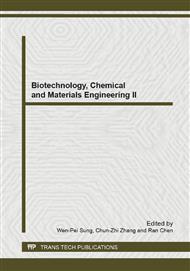p.701
p.712
p.717
p.721
p.725
p.732
p.736
p.740
p.744
Dosimetry Analysis of Three Kinds of Radiation Technique for Postoperative Gastric Cancer
Abstract:
Objective: To compare dose-volume histograms (DVHs) and the dose distribution of three-dimensional conformal radiotherapy(3DCRT),7 fields radiotherapy(7FRT) and intensity-modulated radiotherapy (IMRT) of treatment planning in gastric cancer. Methods: We selected 5 patients with gastric cancer, they were pathologically confirmed stage T3,T4 or N+ gastric cancer. All patients underwent radical gastrectomy. A dosimetry study was carried out on these five patients. For each patient, three kinds of treatment planning were designed with a prescribed dose of 45Gy to 95%of PTV.Many kinds of parameters of these plans in each patient were compared: isodose distributions line、dose-volume histogram(DVH)、V95%、V110%、CI、HI、EI of target volume and the dose of related critical organs. Results: IMRT was superior to 3DCRT and 7F-RT in dose uniformity(p<0.05), there was no statistical difference between 3DCRT and 7FRT in CI(p>0.05).IMRT had better dose conformity than 3DCRT and 7FRT(p<0.05), and 3DCRT was better than 7FRT in CI(p<0.05).IMRT showed better EI than 3DCRT and 7FRT(p<0.05),there was no statistical difference between 3DCRT and 7FRT in EI(p>0.05).IMRT had advantage at sparing liver compared with 3DCRT and 7FRT(p<0.05),7FRT showed better D1/3 of liver than 3DCRT(p<0.05),but there was no statistical difference between 3DCRT and 7FRT in Dmean of liver(p>0.05).IMRT expressed better Dmax of spinal cord than 3DCRT and 7F-RT(p<0.05), and 7FRT was better than IMRT in Dmax of spinal cord(p<0.05).But the dose received by the both kidneys were not significantly different. Conclusion: IMRT is superior to 3DCRT and 7FRT,and 3DCRT plans showed better CI and Dmax of spinal cord composed to 7FRT,and 7FRT was superior to 3DCRT in D1/3 of liver. IMRT for gastric cancer had physics advantage for clinical application.
Info:
Periodical:
Pages:
725-731
Citation:
Online since:
January 2013
Authors:
Keywords:
Price:
Сopyright:
© 2013 Trans Tech Publications Ltd. All Rights Reserved
Share:
Citation:


